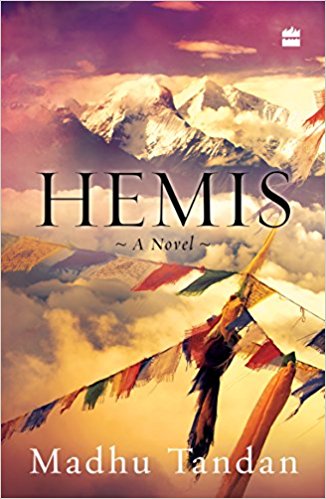There is something about a spiritual thriller that keeps us glued to the pages of a fast-paced story. Hemis is a unique novel in this less explored genre of Indian Writing in English. One may remember Arun Joshi’s ‘strange case’, a narrative delving into tribal lore, but Madhu Tandan takes us to the picturesque, mystical landscape of Ladakh, to a small monastery in the Hemis sanctuary. Imagine being walked through dark corridors, up creaking stairs to be met by an abbot who says nonchalantly, ‘What took you so long?’ Ajay, the corporate honcho from Delhi gets goose pimples—so would any of us—when such familiarity with our secrets is expressed by a stranger in a remote spot. Who then writes the design of your life—you or some other force?
That is the tenor of Hemis. It’s about the unsaid aspects of sexuality and desire, love and loss, grief and mourning. It is a mystery novel; a page turner that will resonate with us city folks whose hectic, action filled quest for material success has stifled the cry of the soul that is on a much longer journey.Though the narrative is deeply layered, I will touch only upon two themes that moved me profoundly and also impressed me with the meticulous research. The first is Tandan’s use of a Buddhist paradigm of sexual gratification as an alternative to what can be called the popular Kamasutra model of physical fulfilment. In Hemis, sexuality is described as a religious-spiritual discipline of human desire that distances itself from the object of desire. When passion is so controlled, the feelings are more substantive, intense and enduring. This Tibetan practice, seldom spoken about but known to scholars, allows even monks to have a ‘Sangyum’ or a spiritual wife participating in an intense experience which is free of physicality. The formula is ‘look, feel, but do not touch’ (p. 187). ‘The key lies in seeing the partner as divine. Every gesture then becomes an act of worship, every sigh a prayer, the gazing into the lover’s eyes a meditation’ (p. 197) . If this sounds too esoteric, the novel works through real life situations to question the limitedness of love and sexuality that is merely biological but fails to invoke the spirit. So we have Ajay and Swati, the ideal Page Three couple whose perfect smiles in public turn into snarls of accusation in private. The absent ‘third’ to the couple is Akansha, the ‘other woman’ who is imagined as a destroyer of this marriage, and so on. Isn’t this a common scenario? Ajay’s month long sojourn in Hemis sanctuary shows him the futility of lives that are lived on the surface but not observed in depth, of assumptions about loyalty and betrayal in conduct that hide far more potent subtexts. And, how does the Oxford educated abbot, administering a remote monastery with minimal resources or human interaction, know so much about the everyday love of men and women in the city? ‘Me, no tell’, he says charmingly to Ajay.

